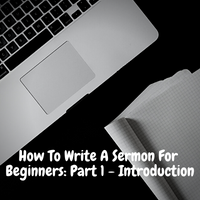My mind is filled with memories of my first year in college in homiletics class struggling to write a sermon, let alone preaching it in front of the other people in the class. The struggle was and is very real: how do I write a sermon that is relevant, interesting, engaging, and life transforming that everyone wants to hear?
After 26 years of ministry and thousands of sermons I can say I am not perfect, but I developed a process that works best for me that I want to share with you. Out of this process take ideas that work for you to develop the process you can use to write your sermons.
There are four parts to my finished sermon. I want to take time to describe each part, tell how I work through each part, and give ideas of how to create each part.
The four parts of my sermon are: Introduction, Exploration, Application, and Invitation
Let’s look at the Introduction.

What Is The Introduction?
The introduction is your starting point, your launch pad of not only into the sermon but the hearts and minds of your audience. Like the old saying goes, “you only have one chance to make a first impression.” The first 90 seconds are crucial to connecting with your audience, because it is within this time that they decide if they are going to listen.
The introduction has more than a connection purpose.
What Is The Purpose Of The Introduction?
When we begin to view a sermon introduction like being introduced to someone new it helps the creative juices to flow. Within those first couple minutes of meeting someone new there is a lot of information that is given and received.
The introduction to a sermon sets the stage for the rest of the sermon, engages the senses, and connects the speaker and the hearer. It is the foundation that the entire sermon is built on, so a weak foundation weak a sermon, a strong foundation a strong sermon.
The introduction enables the listeners to wade into the topic. When a speaker jumps right into the sermon, it is like jumping into the deep end of the pool. There are times jumping right in is ok, but for most of the time it is good to go to the shallow end to wade your audience to the deep end.
The goal of an introduction is to create a tension that is unpacked by the rest of the sermon.

People only give their attention to what they find interesting, compelling or valuable, therefore create tension.
Tension is created by the revealing of a need. The introduction is not merely a prelude to information, but it is setting the table for the tension that will be resolved by the Scripture.
Tension can be created by answering these questions after the main scripture is identified: what beliefs do we have that contradicts the scripture? what behaviors do we have that contradicts the scripture? what life need does the scripture reveal? What life issue does the scripture reveal? what needs to be started, stopped, or adapted in life to fulfill the scripture?
This will be a good place to spotlight my next blog on the Exploration part, the tension created in the Introduction should be resolved in the Scripture.
Ok, we know the purpose of the introduction, how do we write an introduction? I am glad you asked.

How Do I Write An Introduction?
The Introduction should be 5-8 minutes in length. Long enough to capture attention but short enough to avoid boring the audience.
The type of introduction will be influenced by your audience, your scripture, your setting, and your topic. Here are some ways to introduce your sermon:
- Tell an attention getting story. This could be a personal, a church, a community, a state, a national, or a world story that identifies a need. This seems to be the most popular way to introduce a sermon topic.
- Ask an attention getting question. If God loves us unconditionally, why don’t we love ourselves? These questions begin the introspective process that is completed by the rest of the sermon.
- Give an attention getting facts or stats. 10 out of 10 people die. The stated fact or statistic highlights how important it is to listen to the rest of the sermon.
- Present an attention getting prop or image. Place on the stage a prop that becomes an object lesson used to introduce topic. Place an image on the screen that draws people visually into your sermon topic.
- Make an attention getting statement. A donkey talked to Balaam. This is one of the most difficult but effect ways to introduce your sermon. A statement creates an emotional connection right from the beginning.

What Are Good Ideas For Writing An Introduction?
There are some things we can do to make sure our introductions are not predictable and boring but engaging, relevant, and connecting.
- Keep a log of the ways you introduced your sermon. Record sermon title and date then tell which way (story, question, fact, image, or statement) you introduced your sermon.
- Rotate between the various ways of introducing the sermon.
- Ask a trusted friend to read your introduction to see if they can identify your sermon topic.
- When introducing your topic through story don’t always talk about yourself.
- Write the introduction out with the hearer in mind.
- Memorize the introduction.
Conclusion
The importance of an introduction that engages the audience, reveals your topic, and connects emotionally cannot be overstated. Varying your approach to introducing your sermons will help the audience stay attentive with expectation of hearing from God.
Writing a sermon introduction is a craft that can be learned and developed to produce eternal results, because people are drawn into experiencing God through truth.
The process of writing a sermon introduction will take time. It will be difficult at first. But your process will become easier as you write. So begin writing today for your sermon tomorrow.


